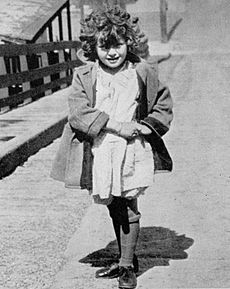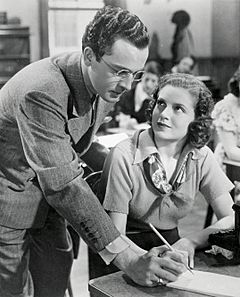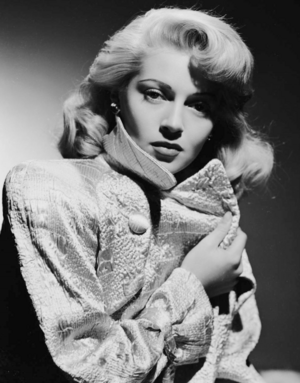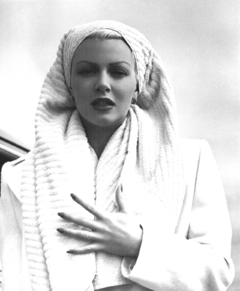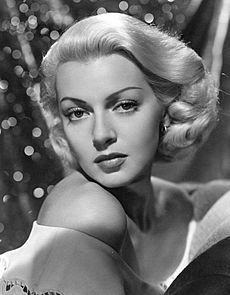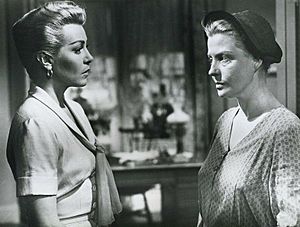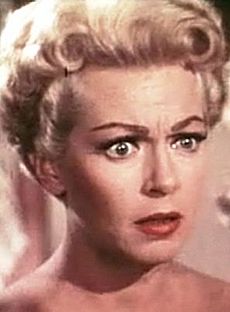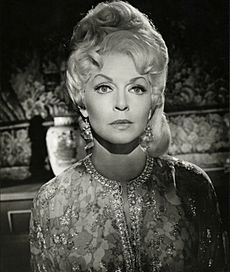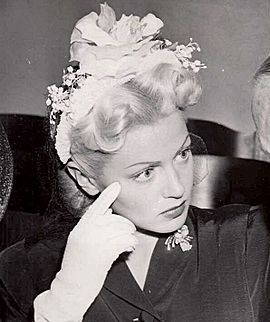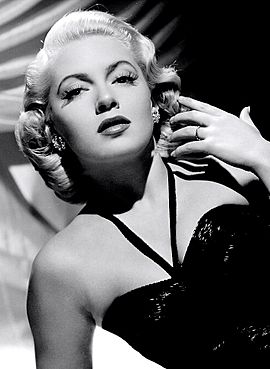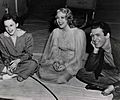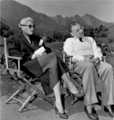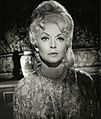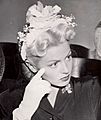Lana Turner facts for kids
Quick facts for kids
Lana Turner
|
|
|---|---|
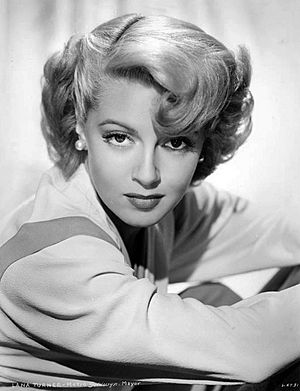
A publicity still of Turner from Metro-Goldwyn-Mayer, 1940s
|
|
| Born |
Julia Jean Turner
February 8, 1921 Wallace, Idaho, U.S.
|
| Died | June 29, 1995 (aged 74) Los Angeles, California, U.S.
|
| Occupation | Actress |
| Years active | 1937–1985 |
| Spouse(s) |
|
| Children | Cheryl Crane |
| Awards | Full list |
| Signature | |
 |
|
Lana Turner (pronounced LAH-nuh; born Julia Jean Turner; February 8, 1921 – June 29, 1995) was a famous American actress. She had a career that lasted almost 50 years. She became well-known as a pin-up model and a movie star. She was also famous for her personal life, which was often talked about in the news.
In the mid-1940s, Lana Turner was one of the highest-paid actresses in the United States. She was one of the biggest stars at Metro-Goldwyn-Mayer (MGM). Her movies earned more than $50 million for the studio during her 18-year contract. Many people remember Turner as a symbol of Hollywood glamour and a legend of classic Hollywood movies.
Turner was born in northern Idaho to working-class parents. Her family later moved to San Francisco. In 1936, when she was 15, she was discovered while buying a soda in Hollywood. At 16, she signed a contract with Warner Bros. director Mervyn LeRoy. He took her with him when he moved to MGM in 1938. She quickly gained attention in her first movie, They Won't Forget (1937). She played a murder victim in this film. Later, she often played supporting roles as a young, innocent character.
In the early 1940s, Turner became a leading lady and one of MGM's top stars. She appeared in movies like Johnny Eager (1941), the musical Ziegfeld Girl (1941), and the horror film Dr. Jekyll and Mr. Hyde (1941). She also starred in the romantic war drama Somewhere I'll Find You (1942) with Clark Gable. Turner became known for her glamorous roles. Her performance in The Postman Always Rings Twice (1946) made her a serious dramatic actress.
Her popularity continued through the 1950s in dramas like The Bad and the Beautiful (1952) and Peyton Place (1957). For Peyton Place, she was nominated for an Academy Award for Best Actress. Her next film, Imitation of Life (1959), was one of her biggest successes. Her role in Madame X (1966) earned her a David di Donatello Award for Best Foreign Actress.
Turner mostly retired in the 1970s. Her last movie was in 1980. In 1982, she took a popular role in the TV series Falcon Crest. This helped the show get very high ratings. In 1992, Turner was diagnosed with throat cancer. She passed away from the illness three years later at age 74.
Contents
Life and Career Highlights
Early Life and Discovery (1921–1939)
Lana Turner was born Julia Jean Turner on February 8, 1921. She was born at Providence Hospital in Wallace, Idaho. This was a small mining town. She was the only child of John Virgil Turner and Mildred Frances Cowan. Her mother was almost 17 when Lana was born.
The family lived in Burke, Idaho when Turner was born. They moved to Wallace in 1925. Her father opened a dry cleaning service and worked in the silver mines. As a child, Turner was called Judy by her family and friends. She loved to perform from a young age. She would do dance routines at her father's club. At age three, she danced at a fashion show where her mother was modeling.
The Turner family faced financial difficulties. They moved to San Francisco when she was six. Her parents then separated. Turner sometimes lived with family friends so her mother could save money. They moved often, living in Sacramento and other parts of the San Francisco Bay Area. After her father passed away, Turner lived in Modesto for a time. She remembered being "treated like a servant" there. Her mother worked very long hours as a beautician. Turner recalled sometimes "living on crackers and milk for half a week."
Turner was baptized as a Protestant. However, she attended Mass with a Catholic family she stayed with. She loved the church's traditions. When she was seven, her mother let her become a Roman Catholic. Turner then went to the Convent of the Immaculate Conception in San Francisco. She even hoped to become a nun. In the mid-1930s, her mother had breathing problems. Her doctor told them to move to a drier place. So, they moved to Los Angeles in 1936.
Turner's discovery is a famous Hollywood story. She was a junior at Hollywood High School. One day, she skipped a typing class and bought a Coca-Cola at the Top Hat Malt Shop. While there, William R. Wilkerson, who published The Hollywood Reporter, saw her. He was impressed by her beauty. He asked if she wanted to be in movies. She said she had to ask her mother first.
With her mother's permission, Wilkerson sent Turner to a talent agent. In December 1936, the agent introduced Turner to film director Mervyn LeRoy. He signed her to a contract with Warner Bros. in February 1937. LeRoy became her mentor. He suggested she use the stage name Lana Turner. She later legally adopted this name.
Turner's first movie was LeRoy's They Won't Forget (1937). It was a crime drama. She played a teenage murder victim. Even though she was only on screen for a few minutes, her performance was noticed. The film gave her the nickname "Sweater Girl" because of her tight-fitting clothes. Turner disliked this nickname. She felt embarrassed when she first saw herself in the movie.
After this film, she appeared in The Great Garrick (1937). In late 1937, LeRoy moved to Metro-Goldwyn-Mayer (MGM). He asked Jack L. Warner to let Turner come with him. Warner agreed, thinking Turner wouldn't become a big star. Turner left Warner Bros. and signed with MGM.
Her first main role for MGM was in Love Finds Andy Hardy (1938). She starred with Mickey Rooney and Judy Garland. During filming, Turner finished her high school studies. The movie was a big success. MGM helped Turner's career by giving her roles in youth-focused films. These included Rich Man, Poor Girl (1938) and Dramatic School (1938). She was then cast in Calling Dr. Kildare (1939). This was followed by These Glamour Girls (1939) and Dancing Co-Ed (1939). Dancing Co-Ed was a commercial success. It led to Turner appearing on the cover of Look magazine.
In February 1940, Turner married bandleader Artie Shaw. They had known each other only briefly. Their marriage lasted only four months. MGM executives were concerned about her quick decisions. During her marriage to Shaw, she starred in We Who Are Young.
Becoming a Star (1940–1948)
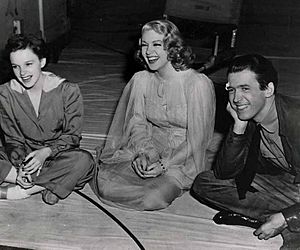
In 1940, Turner appeared in her first musical film, Two Girls on Broadway. The next year, she had a main role in Ziegfeld Girl. She starred with James Stewart, Judy Garland, and Hedy Lamarr. Turner said this was the first role that made her "interested in acting." The studio was impressed. They promoted the film as her best role in their biggest picture. The film's success increased Turner's earnings. MGM raised her weekly salary and gave her a personal makeup artist and trailer. After the film, Turner and Judy Garland became lifelong friends.
After Ziegfeld Girl, Turner took a supporting role in Dr. Jekyll and Mr. Hyde (1941). She starred with Spencer Tracy and Ingrid Bergman. The film was a financial success. Turner was then cast in the Western Honky Tonk (1941). This was the first of four films she made with Clark Gable. Rumors about their friendship often helped their movies succeed. Her next project was Johnny Eager (1941).
As the U.S. entered World War II, Turner became a popular pin-up girl. Her image was painted on U.S. fighter planes. In June 1942, she went on a 10-week war-bond tour with Gable. She promised kisses to those who bought the most war bonds. In Portland, Oregon, she sold a $5,000 bond for two kisses. She sold another for $50,000. When she visited her hometown of Wallace, Idaho, she was welcomed as a hero. The mayor declared a holiday in her honor. Turner sold $5.25 million in war bonds during the tour. She continued to visit U.S. troops and bases.
In July 1942, Turner met her second husband, Joseph Stephen "Steve" Crane. They married quickly. Their marriage was later canceled because Crane's previous divorce was not final. After finding out she was pregnant, Turner remarried Crane in March 1943. She gave birth to her daughter, Cheryl, on July 25, 1943. Cheryl was born with a serious blood condition.
In August 1944, Turner divorced Crane due to personal differences. She spent the rest of the year supporting Franklin D. Roosevelt in the 1944 presidential election. In 1945, she starred in Keep Your Powder Dry. This was a war drama about three women who join the Women's Army Corps. She then played the lead in Week-End at the Waldorf. This film was a box-office hit.
After the war, Turner starred with John Garfield in The Postman Always Rings Twice (1946). This was a crime film based on a novel. She played Cora, a woman who falls in love with a drifter. They plan to murder her husband. This movie was a turning point for Turner. She played a strong, mysterious woman. Critics praised her performance. Life magazine called it their "Movie of the Week." The film was a major success.
In August 1946, Turner was chosen for the historical drama Green Dolphin Street (1947). She changed her hair color and lost weight for the role. She played the daughter of a wealthy man. She falls in love with a man who loves her sister. Turner was surprised to get the role. She said she was "the most un-Hepburnish actress on the lot." She did not wear much makeup and her hair was messy in the film. But she still wanted to keep her glamorous image.
Turner's next film was the romantic drama Cass Timberlane. She played a young woman in love with an older judge. The filming was difficult because it was done between retakes of Green Dolphin Street. Critics praised Turner's performance in Cass Timberlane.
In August 1947, Turner appeared in Homecoming (1948). She was again paired with Clark Gable. She played an army lieutenant who falls in love with an American surgeon. The film was popular. Turner and Gable were called "the team that generates steam." By this time, Turner was at the peak of her career. She was MGM's most popular star. She was also one of the ten highest-paid women in the U.S.
New Roles and Challenges (1948–1957)
In late 1947, Turner played Lady de Winter in The Three Musketeers. This was her first Technicolor film. Around this time, she started dating Henry J. "Bob" Topping Jr. He was a millionaire. They married in April 1948. Turner's wedding celebrations caused her to be late for filming. The studio head threatened to suspend her contract. But Turner used her popularity to get a bigger role and a higher salary. The Three Musketeers was a success.
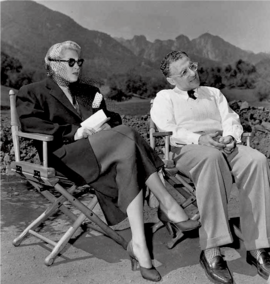
In 1949, Turner was to star in A Life of Her Own (1950). This was a drama about a woman who wants to be a model. The project was delayed. Turner was eager to start filming. She felt it was unhealthy to be off screen for so long. The film was not very successful. On May 24, 1950, Turner placed her handprints and footprints in cement at Grauman's Chinese Theatre.
MGM tried to change Turner's image by casting her in musicals. The first, Mr. Imperium (1951), was not successful. Turner played an American woman who is pursued by a European prince. She recalled that the script was "stupid." Her performance received negative reviews.
During this time, Turner faced financial difficulties. The next year, she filmed her second musical, The Merry Widow (1952). This film was more successful than Mr. Imperium.
Turner then starred with Kirk Douglas in The Bad and the Beautiful (1952). This drama was about a Hollywood film producer. Turner played a movie star. The film was a success. Critics praised her performance. In December 1952, Turner divorced her third husband, Bob Topping. She later said his drinking and gambling were the reasons. Her next film was Latin Lovers (1953).
In spring 1953, Turner moved to Europe for 18 months. She made two films there for tax reasons. These were Flame and the Flesh and Betrayed. Betrayed was her last film with Clark Gable. In September 1953, Turner returned to the U.S. She married actor Lex Barker.
In 1955, Turner starred in the Biblical film The Prodigal (1955). She did not want to be in the film. She disliked the costumes and lines. The film received mixed reviews. Turner was then cast in The Sea Chase (1955) with John Wayne. This adventure film was a commercial success.
MGM then gave Turner the main role in Diane (1956). This period drama had been planned for Greta Garbo years earlier. After Diane, Turner was loaned to 20th Century-Fox. She starred in The Rains of Ranchipur (1955). This film was rushed and received negative reviews. Diane was not successful. In February 1956, MGM decided not to renew Turner's contract. Turner was happy to be a "free agent" after 18 years. At the time, her films had earned MGM over $50 million.
In July 1957, she divorced Barker. Weeks later, Turner began filming Peyton Place. She played Constance MacKenzie, a New England mother. She struggled to have a good relationship with her teenage daughter. The film was a huge success. Turner received a percentage of the film's earnings instead of a salary. She also received critical praise. For the first and only time, she was nominated for an Academy Award for Best Actress.
Later Career and Television (1959–1985)
Turner accepted the lead role in Imitation of Life (1959). She played a struggling stage actress. She made personal sacrifices for her career. The filming was difficult for Turner because of recent events in her personal life. She had a panic attack on the first day.
Released in spring 1959, Imitation of Life was one of the biggest successes of the year. It was the biggest of Turner's career. By taking a percentage of the film's earnings, she earned over two million dollars. Imitation of Life made more than $50 million at the box office. Critics noticed that the plots of Peyton Place and Imitation of Life seemed to reflect parts of Turner's private life. Both films showed the difficult relationship between a single mother and her teenage daughter.
Shortly before Imitation of Life was released, Turner was cast in Anatomy of a Murder. But she left the set over a disagreement about costumes. She was replaced by Lee Remick. Instead, Turner took a lead role in Portrait in Black (1960). This film was a success despite bad reviews.
In November 1960, Turner married her fifth husband, Frederick "Fred" May. He was a rancher. Turner moved to his ranch in Chino, California. The next year, she made her last film at MGM, Bachelor in Paradise (1961). This romantic comedy received good reviews. Turner then starred in By Love Possessed (1961). This film became the first movie shown regularly on a scheduled airline flight.
In mid-1962, Turner filmed Who's Got the Action?. This was a comedy with Dean Martin. In September of that year, Turner and May separated. They divorced in October but remained friends. In 1965, she met Hollywood producer Robert Eaton. They married in June of that year.
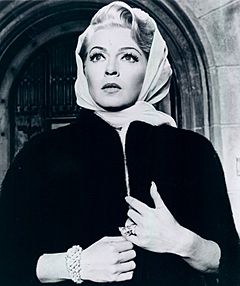
In 1966, Turner had her last major starring role in Madame X. This was a courtroom drama. Turner played a woman who marries into a wealthy family. Critics praised her performance. The role earned Turner a David di Donatello Golden Plaque Award for Best Foreign Actress.
In late 1968, she filmed the low-budget thriller The Big Cube. One critic called her acting "strained and amateurish." In April 1969, Turner divorced Eaton. Weeks later, on May 9, 1969, she married Ronald Pellar. He was a nightclub hypnotist. According to Turner, Pellar made false claims about himself.
With few film offers, Turner appeared in the television series Harold Robbins' The Survivors. It premiered in September 1969. Despite a big marketing campaign, the show did not do well. It was canceled after 15 weeks in 1970. After six months of marriage, Turner discovered Pellar had taken money she gave him for an investment. She also accused him of taking jewelry. She filed for divorce in January 1970. Turner married a total of eight times to seven different husbands. She famously said: "My goal was to have one husband and seven children, but it turned out to be the other way around."
Turner returned to films with a lead role in the 1974 British horror film Persecution. She played a wealthy woman tormenting her son. Her next film was Bittersweet Love (1976).
In the early 1970s, Turner started working in theater. She began with a production of Forty Carats in 1971. From 1976 to 1978, she starred in a touring production of Bell, Book and Candle. In the fall of 1978, she appeared in a Chicago play called Divorce Me, Darling.
Between 1979 and 1980, Turner appeared in Murder Among Friends. In 1980, Turner made her final film appearance in Witches' Brew. The same year, she had a "religious awakening" and returned to her Catholic faith. On October 25, 1981, she received an Artistry in Cinema award. In December 1981, it was announced that Turner would appear in an episode of Falcon Crest. This was her first TV role in 12 years. Her appearance was a ratings success. She returned for five more episodes.
In January 1982, Turner reprised her role in Murder Among Friends. She released her autobiography, Lana: The Lady, the Legend, the Truth, in September. She guest-starred on The Love Boat in 1985. This was her final on-screen appearance.
Later Years and Passing (1986–1995)
Turner was a regular smoker for most of her life. In her early 60s, she stopped drinking to stay healthy. But she could not quit smoking. She was diagnosed with throat cancer in spring 1992. She said the cancer was found early and did not harm her voice. She had surgery, but the cancer had spread. After radiation therapy, Turner announced she was in full remission in early 1993. The cancer returned in July 1994.
In September 1994, Turner made her last public appearance. She accepted a Lifetime Achievement Award in Spain. She was in a wheelchair for much of the event. She passed away nine months later on June 29, 1995, at age 74. She died from complications of cancer at her home in Century City, Los Angeles. Her daughter was with her. According to Cheryl, Turner's death was a "total shock." Turner's remains were cremated.
Cheryl and her partner inherited some of Turner's personal items and $50,000. Turner left most of her estate to her maid, Carmen Lopez Cruz. Cruz had been her companion for 45 years and caregiver. Cheryl challenged the will. Cruz said that most of the estate was used for legal and medical expenses.
Public Image and Legacy
When Turner was discovered, MGM executive Mervyn LeRoy saw her as a replacement for the late Jean Harlow. In her early films, Turner had auburn hair. Ziegfeld Girl (1941) was the first film to show Turner with platinum blonde hair. She kept this hair color for most of her life.
After Turner's first marriage in 1940, a columnist wrote that she was "headed for a top spot in motion pictures." She was called "the most glamorous actress since Jean Harlow." By the mid-1940s, Turner had been married and divorced three times. She had also given birth to her daughter Cheryl.
By the 1950s, people started to see similarities between Turner's personal life and her movie roles. This was most clear in Peyton Place and Imitation of Life. Both films showed single mothers struggling with their teenage daughters. Film experts say Turner was one of Hollywood's first stars whose private life greatly influenced her career. Her movies often showed characters and situations that matched her public image.
Turner is remembered as one of the most glamorous film stars ever. She once told a journalist, "Forsaking glamour is like forsaking my identity." She worked hard to keep her glamorous image. She always made sure she looked "camera-ready." She wore jewelry and makeup even when relaxing. Turner often bought her favorite shoe styles in every color. She once had 698 pairs of shoes.
Historians have noted that women fans liked Turner. She maintained her glamorous image throughout her career. She was also dedicated to acting. She was known as a versatile and hard-working performer. She admired Bette Davis, calling her her favorite actress.
Turner is seen as a popular culture icon. She is a "symbol of the American Dream fulfilled." Her story of being discovered at a soda fountain is famous. She is also considered a gay icon because of her glamorous image and how she overcame challenges.
Some critics have different opinions about her acting legacy. Upon her death, one writer said her films "didn't amount, retrospectively to much." However, others praise her acting in films like The Postman Always Rings Twice. Her role in that film often links her to the "femme fatale" character in movies.
Turner is part of discussions about the Hollywood studio system. This system often used stars' private lives for publicity. She is seen as a perfect example of "Hollywood machine-made stardom."
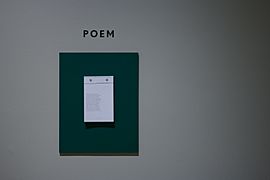
Turner has been shown and mentioned in many books, films, music, and art. She was the subject of a poem called "Lana Turner has collapsed" by Frank O'Hara. She was also a character in James Ellroy's novel L.A. Confidential (1990). In music, Turner was mentioned in songs by Nina Simone and Frank Sinatra. Singer-songwriter Lana Del Rey chose her stage name because of Lana Turner. In 2002, artist Eloy Torrez included Turner in a mural at Hollywood High School. Turner has a star on the Hollywood Walk of Fame. In 2012, Complex magazine named her the eighth-most famous actress of all time.
Images for kids
-
Judy Garland, Turner, and James Stewart on the set of Ziegfeld Girl (1941), which precipitated her rise at MGM
-
Turner and Betty Field in Peyton Place (1957), which earned Turner an Academy Award nomination
-
Turner's role in Madame X (1966), earned her a David di Donatello Golden Plaque
-
Copies of the poem "Lana Turner has Collapsed" (1964) by Frank O'Hara at the Museum of the City of New York
See also
 In Spanish: Lana Turner para niños
In Spanish: Lana Turner para niños


